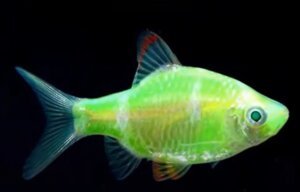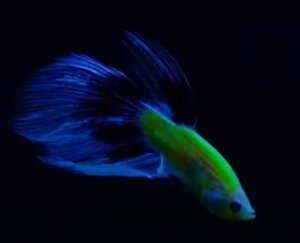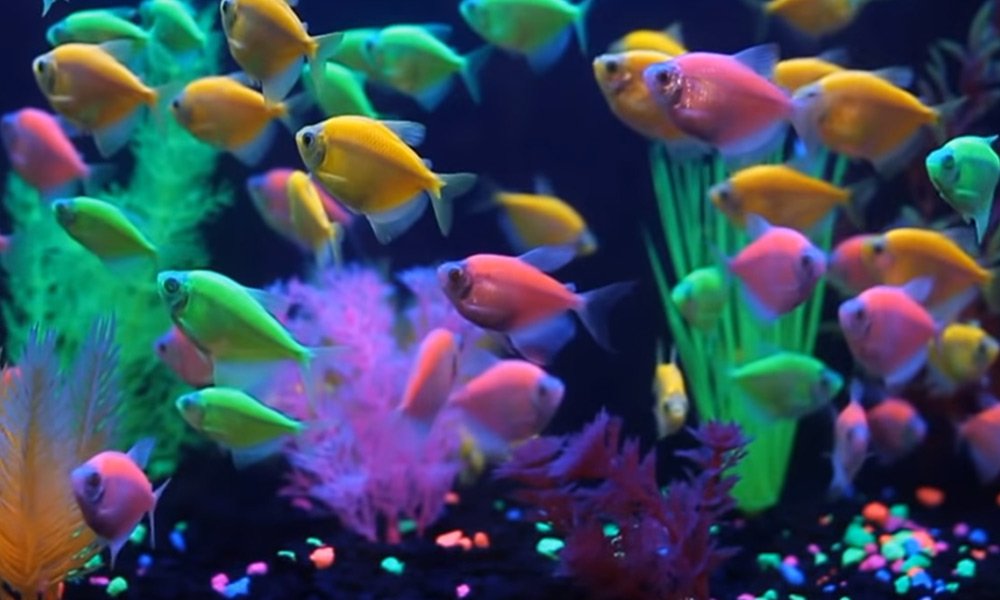Unlike anything else in the world of fish in aquariums is the Glofish! They are magnificently colored, spectacular fish which have had a natural fluorescence gene added to their genome, resulting in fish that are permanently fluorescent. In this article we delve into the question: How Many Glofish in a 10 Gallon Tank?
We also look at how glofish were developed and the care requirements for the different glofish species.
Introducing the Glofish

Due to bright neon colors, these fish have become extremely popular amongst beginner fish-keepers.
Genetically modified glofish are born with brilliant color, maintain it throughout their lives, then pass the color to their offspring.
Glofish have the same general care requirement, including temperature and food preferences as their non-fluorescent counterparts.
They are great in a community aquarium! The best way to experience glofish is by using blue lighting. This is included in all branded Glofish aquarium kits to help everyone ‘take home the glow!’
Glofish have been developed from several species of aquarium fish. Later in the article we consider each of these species and their individual care needs.
Prices pulled from the Amazon Product Advertising API on:
Product prices and availability are accurate as of the date/time indicated and are subject to change. Any price and availability information displayed on [relevant Amazon Site(s), as applicable] at the time of purchase will apply to the purchase of this product.
Glofish History- How Did They Come About?
Back in 1999 a group of scientists in Singapore were working with a gene extracted from a jellyfish that produced a bright green, fluorescent coloration. They then inserted this gene into a Zebra Danio embryo, allowing it to integrate into the fish’s genome.
These fish would then be fluorescent green under white light or ultraviolet lights. They then filed a patient on their work.
Next, they created a red florescent Zebra Damio using genes from a sea coral. The scientists then met with businessmen from Yorktown Technologies and created a deal to have world wide rites to market the new Zebra Danios branded as Glofish.
Are Glofish as Hardy as the Fish They Were Developed From?
So essentially Glofish are genetically modified, or GMO fish. Since then, there have been several new forms of glofish using other tropical fish species.
The glofish available on the market now include the Zebra Danio, Tiger Barb, Rainbow Shark, White Skirt Tetra, and Betta Fish.
The fish that glofish were developed from were all considered to be hardier- more ‘forgiving’ fish when mistakes are made with water parameters. Unfortunately, these new varieties don’t seem to be quite as hardy as their new counterparts.
So, is it that they are less hardy, or is it because they have been kept in inappropriate environments?
How Many Glofish in a 10 Gallon Tank? Things to Consider.

There is a lot of good to be said about glofish because of the bright colors. These fish are very attractive to a younger audience. They can add a great bit of color to a community aquarium.
The worst thing about glofish, is not the fish themselves, but more the tanks that are marketed for the fish.
For example; the largest aquarium kit marketed for glowfish is 10 gallons, whilst most of the species that glofish have been developed from require a minimum of a 20 to 30 gallon tank for optimal fish health.
So, you can see how this might be confusing to a lot of fishkeepers!
Prices pulled from the Amazon Product Advertising API on:
Product prices and availability are accurate as of the date/time indicated and are subject to change. Any price and availability information displayed on [relevant Amazon Site(s), as applicable] at the time of purchase will apply to the purchase of this product.
Another issue with these fish is that they were genetically modified to have bright lighting bring out their florescent colors. The species used to develop the glofish become stressed if kept in brightly lit tanks. As with White Tipped Tetras and Betta fish being examples of this.
The glofish are really not the problem, the problem is how they are marketed and how the products for them are marketed.
Co-inhabitants and Fish Behaviors that Determine Tank Size
Glofish cannot just be added to any community aquarium expecting that all aquatic life in the tank will be happy. Some glofish species like Tiger Barbs and Bettas tend not to get along well with others without careful planning and sufficient space in the tank.
Tiger Barb glowfish cannot be mixed with Betta fish glofish. Tiger Barbs are well known fin nippers. They will also outcompete the bettas for food.
Tiger Barb glofish are better kept in larger groups of ten fish. This reduces their nipping tendencies.
The rule of thumb of 1 gallon of water per Tiger Barb, definitely doesn’t work when considering a 10-gallon tank!
A 10-gallon tank is way too small for 10 Tiger Barbs. At the very least you would need a 20-gallon tank. Really, 30 gallons or more is better.
Prices pulled from the Amazon Product Advertising API on:
Product prices and availability are accurate as of the date/time indicated and are subject to change. Any price and availability information displayed on [relevant Amazon Site(s), as applicable] at the time of purchase will apply to the purchase of this product.
Wrong Advice from the Glofish Website
The glofish website does not have really good information on how to care for their florescent fish properly.
For example: the official glofish website recommends a tank of 10 gallons for a group of 6 Betta female fish. A 10-gallon tank will not be adequate for six female bettas. You would want at least a 20-gallon tank. Bigger always means better!
The truth is, while some people may object to glofish being sold on the market, as long as they keep selling, they will keep coming out with new species of glofish.
The best thing we can do is to research the specific species they were developed from and try to educate ourselves on how to best take care of them.
Focus a little less on what will best show off the bright colors of the fish, but more on the fish’s needs for it to thrive in your tank.
How Many Glofish in a 10 gallon tank? Shape Does Matter
If you do decide to house your glofish in a 10-gallon tank, then considering the shape of the tank will help your fish with finding the space to move as it would do naturally.
Tall thin tanks are less suitable. Tetras, tiger barbs and danios are schooling fish and need space to move left to right. Housing them in a longer tank is better.
The same goes for betta fish. These fish originated from shallow waters where they swim from side to side.
Glofish Species and Their Specific Needs
Zebra Danio Glow Fish

Being the original glofish, they have developed several color strains. Today they are available in five colors: Electric Blue, Star Fire Red, Sun Burst Orange, Cosmic Blue, and Galactic Purple.
Danios require at least a 10 gallon tank. They are fast ‘busy’ fish suited for busy aquariums. They like to swim in the upper portions of the tank.
Danios are schooling fish, so they need to be kept in groups of at least five. If the numbers are too low they become stressed, which can lead to illness and social problems in the aquarium.
These colorful fish need plenty of space to swim around. They cohabitate with Tiger Barb glofish and White Skirt Tetra glofish, so long as they have room in the tank.
Your aquarium would need a lid, as danios like to jump. A filter or aquarium water pump that creates a current will excite danios. They like to dance around in the current.
Water Parameters:
- Temperature: 65° – 75°F
- pH: 6.5 – 7.2
- Water hardness: 3 – 8 dkH (soft to medium)
Tiger Barb Glofish

The glofish version of the tiger barb comes as a florescent green called the Electric Green Tiger Barb.
Tiger Barbs require a minimum tank size of 20 gallons (30+ gallons is better). Being avid swimmers, they need space to race around the tank pursuing each other.
Tiger Barbs grow to three inches if provided with the right conditions. So, having 6 to 10 barbs in a ten gallon tank would make it way to crowded. A larger tank will lessen any aggressive behaviors.
Water Parameters:
- Temperature- 68° – 82°F (74° F best)
- pH range- 6.0 – 8.0 (slightly acidic is best)
- Water hardness- 4 – 10 dkH
White Skirt Tetra Glofish

There have been three glofish color versions developed from the White Skirt Tetra. These are: Electric Green, Sunburst Orange, and Moon Rise Pink.
This species is a schooling fish, with fish growing to two inches long. Schooling fish, because they need to be in numbers, require a large tank of at least 20 gallons (114L).
It is best to keep them in groups of five or more in a community tank, otherwise they are susceptible to getting their fins nipped.
Water Parameters:
- Temperature: 75° – 80°F
- pH range: 6.0 – 7.5
- Water hardness: 5 – 20dkH
Rainbow Shark Glofish
Sometimes known as the Red Finned or Ruby Shark, are a semi-aggressive fish towards other species with long fins such as guppies, bettas and goldfish.
An adult rainbow shark thrives in a tank with a minimum of 55 gallons of water and an aquarium length of 48 inches. This species grows to six inches (15 cm) long and require room to move. A 10 gallon tank would not suffice.
Rainbow Sharks are bottom to mid-level tank occupants who will get along with Tiger Barb glofish.
The Glofish brand has developed a purple/pink florescent Rainbow Shark which is names Galactic Purple.
Water Parameters:
- Temperature: 75 – 81 °F (24 – 27 °C)
- pH range: 6 – 8
- Water hardness: 5 – 11dkH
Betta Fish Glofish

The betta glofish cause quite the controversy in the fish-keeping community. The glofish brand developed the Electric Green Betta with a florescent green color. The basis of the controversy is that the betta fish is already a stunningly colorful fish which is super popular with fish enthusiasts. The glofish betta doesn’t match up to the range of patterns and colors of bettas that have been selectively bred for many years.
The other problem with the glofish betta is that it doesn’t have the desired fins.
As pointed out earlier, the glofish website recommends six female glofish bettas for their 10-gallon tank. Our view is that one betta fish requires a minimum of 5 gallons or larger for it to have space to move and for water parameters to keep stable.
Betta fish are not social fish and need room between individuals. Females will tolerate one another, but will become stressed if crowded together. When this happens social problems occur and fins may be nipped.
Water Parameters:
- Temperature: 75 – 81°F (23.8 – 27.2°C)
- pH range: 6.5 – 7.5
- Water hardness: 3 – 5 dkH
- GH: 3 – 4 dGH
Final Thoughts
Whether you have an aversion to GMO developed organisms or not, the glofish are now well established with the aquarium hobby and we all agree that the colors that have been developed are unique and eye catching, especially in an aquarium with ultraviolet lighting!
Our responsibility with keeping pets is to ensure they are kept in appropriate tanks where their needs can be met that replicate their natural habitats. ‘How Many Glofish in a 10 Gallon Tank’ is not the question that should be asked, but rather; What size tank would be suited best for the species of fish intended to be kept? This goes for aquarium equipment as well- lighting systems, filters and heaters.
Whatever you decide, we wish you every success with keeping glofish.
You may be interested in our article “How Many Glofish in a 5-gallon Tank?” It is quite a different article to this one.
.















